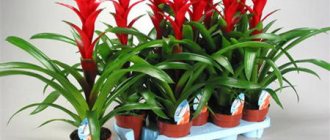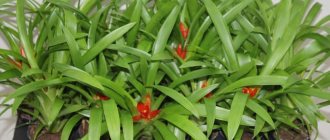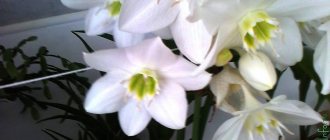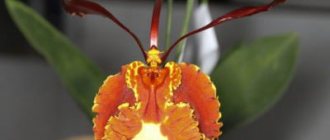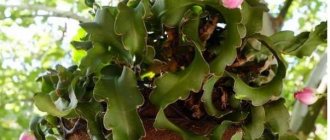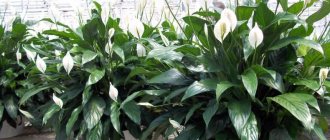A plump head of cabbage with long green flowing tongue-leaves is an epiphytic or terrestrial plant of the Bromeliaceae family (Bromeliaceae) - guzmania or guzmania.
Caring for guzmania at home is not difficult, it pleases with its colorful cones-panicles for a long time, so the spectacular fat plant enjoys well-deserved popularity as a pet plant among many lovers of indoor flowers.
When is it time to replant a flower?
Planting in a new pot is done only once - after purchase, in order to create favorable conditions for the growth and development of Guzmania and not disturb it anymore. In other cases, only children are transplanted at home for further reproduction.
Types of flowering
Important! The plant must be replanted carefully by transferring it from the previous location to a new pot. It is important to preserve the earthen ball around the roots as much as possible, since the roots of the plant are very thin and fragile.
Diseases and pests of indoor plants
Important. Guzmania is a very unpretentious plant.
But there are still pests that are dangerous to it. This:
- mealyworm;
- scale insect;
- spider mite
They damage the leaves. To get rid of parasites, you need to treat them with a soap solution or, in more advanced cases, spray them and pour insecticides into the outlet.
Another possible problem is fungus. Its presence is indicated by gray spots on the leaves. Furgicides will help cure the plant.
How to propagate Guzmania
Guzmania: plant transplantation and home care
Flower planting can be done after the plant has finished blooming. Around the base, lateral shoots (babies) are formed, on which a separate root system appears. As soon as the length of the root has reached 1.5 cm, the sprout must be cut off with a very sharp tool and the cut should be treated with garden varnish or crushed activated carbon. The second propagation option is using seeds.
Root system
The flower has dried up: what to do, is it possible and how to save it?
After the buds fade, the plant begins to lose its bright color and subsequently dries out. This is considered the norm characteristic of this plant. You should not start adding fertilizer or heavily watering the flower, this will not help save its life.
However, you can take care of the continuation of his family; for this, the following manipulations are performed:
- Cut off the flower stalk.
- Pour water into the tray, but not into the pot.
- Remove dried leaves that appear periodically.
- When the plant dries completely, children or daughter shoots should form, which are then transplanted into a separate pot.
It is impossible to save or revive the mother flower.
Guzmania - transfer
Monstera - home care, transplantation and reproduction
If necessary, you can replant the plant at any time. But it is better to choose the spring months of the year for this, so that the plant blooms in the summer.
What happens if the children are not sent away?
After the mother plant has flowered and the babies have formed, the main plant begins to die. You need to wait until it completely dries and remove it, and the children will take root in the existing pot, if its size allows this.
Death of the mother plant
Preparing for transplant
In addition to purchasing a pot, before replanting it is necessary to carefully treat the plant and prepare the soil.
Choosing a pot
The container needs to be massive so that the bush does not turn over, because the upper part may become heavier than the lower part over time. The depth of the pot should be no more than 12 cm, and the diameter should be up to 15 cm, that is, you need a low but wide container. The deeper it is, the greater the likelihood of soil rotting, which the root system does not reach.
Drainage preparation
Drainage makes up 1/3 of the entire pot. It serves to absorb excess moisture. For this purpose, you can use expanded clay, wood charcoal, polystyrene foam, or a mixture of these substances.
Drainage
It is best to use more coal, it will act as an anti-infective agent. The rest of the filling of the pot should consist of crushed moss, peat or old wood, because this is the natural habitat of the flower.
Plant treatment
When replanting an adult plant, you need to remove old, dry or damaged roots and treat the cut areas. It is better to treat the roots of the children, which are separated from the main plant, with a growth stimulating agent.
Problems when growing Guzmania
Amateur flower growers are interested in solving problems that arise when growing crops:
Guzmania does not bloom and is stunted in growth. In order for the plant to go through all stages of the growing season, conditions close to natural are created. Suitable temperature and air humidity, rationing of watering, diffused but sufficient lighting are important. To ensure there is enough nutrients, the crop is fed at least once a month (except in winter).
Guzmania leaves wither for unknown reasons. Leaf blades droop and wither due to excess or lack of moisture in the air or rosette. When sunburn occurs, brown spots appear and the tips of the leaves curl.
No daughter shoots were formed. Children are formed on time if the peduncle is cut off immediately after flowering.
How to transplant Guzmania at home
Guzmania - home care, transplantation and reproduction
In order for the transplant to take place quickly and without problems, you need to prepare in advance everything that will be needed:
- a sharp knife, having previously treated it with alcohol;
- spatula;
- growth agent;
- pot.
To replant an adult plant, it is cleared of old roots. Next, the soil is processed and slightly dried. Transfer the guzmania to a new container and add fresh soil.
Transplanting a plant
How to transplant Guzmania babies:
- Carefully separate the babies from the main plant with a knife.
- Transfer them to paper and let dry for one hour.
- Place a drainage layer equal to 1/3 of the total volume at the bottom of the pot. Sprinkle a small amount of soil on top and place a young sprout in the center.
- Gently straighten the roots and cover with the rest of the prepared soil until the roots are completely covered.
- Compact, but do not water the soil, but only lightly spray it with a spray bottle.
Note! The soil should not be flooded so that the roots can get used to the new habitat and not deteriorate at an early stage.
For best results, the children should be planted in a separate pot filled with orchid soil. Place it in a warm room and cover it with polyethylene to create increased humidity.
How to propagate the “tropical crown”?
Like most plants, guzmania reproduces in 2 ways:
- The simplest is vegetative (for children).
- Requires patience - generative (by seeds).
Vegetative
At the end of flowering, the mother rosette is no longer a resident. But the little baby daughters that appeared during flowering already have long roots (1.5-2 cm) by this time, so they can easily transfer the transplant to their “new apartments”.
We carefully remove the old plant from the pot and separate the children from it if their height has already reached 15 cm. With normal care, this growth corresponds to 4 months of life for the daughters.
We place those children that are ripe for transplanting in small pots filled with soil for orchids.
To create comfort, we cover the pots with transparent jars and wait for the plants to start growing, maintaining the temperature from +26 to +28°C and the required humidity.
Those babies who have not yet reached the height and length of roots required for transplantation are sent back to their mother’s pot along with the adult guzmania cut off at the root to grow. In this case, the transplantation of children is postponed.
Don't rush into planting daughter shoots! Small guzmanias attached to the mother root develop better and grow stronger.
It is best to separate children for transplantation in the spring. If during flowering the epiphyte does not throw out daughter shoots, it means that it did not have enough nutrition. Feeding for 10-15 days should solve the problem.
Method "from seeds"
This is not the best propagation option, since epiphyte seeds have a germination rating of “below average,” and hybrid varieties do not inherit parental qualities at all. Therefore, the generative method is used in extreme cases.
The step-by-step process of obtaining guzmania from seeds looks like this:
- We treat purchased or collected seeds with a weak solution of potassium permanganate, aloe juice, or an auxin stimulant (for example, liquid solution HB-101, diluting one drop of it in half a liter of water). We stand from 14 to 72 hours, focusing on the freshness of the seeds.
- We fill the container for sowing with soil for orchids mixed with sand 3x1. The layer of seeding soil is 3-4 cm.
- We distribute the prepared seeds evenly over the peat-sand cushion, without embedding them into the soil.
- We tighten the container on top with cling film or cover it with glass. We place it in a well-lit place where the temperature does not drop below +23-25 °C.
- Ventilate daily and spray with a warm solution of Fitosporin-M (according to the instructions for the drug). If necessary, we spill the soil with heated (+37-38 °C) melt water. Melt water can easily be obtained by freezing regular tap water.
- Guzmania seeds germinate in about 20 days. They are picked after 2 months. All this time we ventilate, spray, spill.
- After 2-2.5 months, we very carefully transplant the green shoots into pots with the soil composition: peat (4 parts) + leaf soil (2 parts) + chopped turf (1 part). In order not to injure the roots, it is better to plant the first greens in pairs or triplets if they are intertwined.
- After another 5-6 months, we distribute the seedlings into our own permanent “apartments” in soil usual for bromeliads.
- If the plant begins to grow vigorously, then everything has been done correctly, but the young guzmania may need to be transferred to a more spacious pot.
With the generative (seed) method, it is necessary to take into account that the flower will throw out a plume only after 4-5 years.
And sometimes such a Guzmania seedling does not bloom at all, although all the conditions for care and replanting are met. Why?
How to separate Guzmania babies. Video:
How to separate Guzmania babies
Caring for the plant after transplantation
In order for the work to produce results, it is necessary to observe proper care after transplanting Guzmania.
Location and contents
In winter and spring, the temperature in the room should not exceed 21 degrees Celsius, humidity should not be lower than 60%. The pot should be placed away from direct rays and heat sources. In summer and autumn, the plant needs a temperature of +20...+25 degrees, humidity - from 65 to 80%. Direct sunlight should hit the guzmania only after lunch. To maintain humidity at the required level, place the pot on a stand with moistened moss.
How to water and fertilize
The water should be filtered and at room temperature. Watering is not done on the ground, but inside the plant. If liquid remains inside the socket, it must be drained or wetted with a napkin. To prevent rotting, in summer watering should be done 2 times a day; in winter, 1 time a week is enough.
How to water Guzmania
Guzmania does not need fertilizer, since the composition of the soil already nourishes it. But you can fertilize to continue flowering. Any of the selected products must be dissolved in water.
Note! The dose should be reduced by 4 times from what is indicated on the package.
Reproduction
There are 2 ways to propagate a flower - by seeds and by separating shoots. The plant lives up to 3 years, and when buying an adult plant you need to be prepared for the fact that it will soon wither. During this time, you will need to propagate Guzmania with the help of children. Propagation by seeds is more painstaking work.
Main types and varieties of Guzmania
Of the numerous representatives of Bromeliads, the following varieties have taken root in indoor floriculture:
- Guzmania reed. In nature, it is a stemless plant with weak roots and short red bracts. Based on this species, such popular groups of Guzmania varieties as Minor (Minor Rondo), Mix and Tempo were bred. These are low plants with bracts of different colors - yellow, pink, golden-green.
- Guzmania is blood red. Its lanceolate, downward-bending leaves form a dense, goblet-shaped rosette. The plant is compact, about 20 cm in height. Flowers without peduncles are located directly in the leaf rosette. The bracts are red or yellow. During flowering, all the leaves of the rosette become colored, and the color is uneven.
- Guzmania mosaic. It grows up to 50 cm. Its long, up to 80 cm, leaves are decorated with transverse light stripes. Peduncles are low, erect; The flowers are white, small, protected by yellow sepals. The inflorescences are large and dense, attractive. The bracts are bright pink.
- Guzmania Donnell-Smith. A compact plant with beautiful dark green leaves and a graceful rosette. The inflorescence is a panicle. This guzmania began to be grown as an indoor flower relatively recently.
Breeders are actively working to develop new hybrids and varieties and improve their qualities. For example, Guzmania Ostara, obtained by crossing different natural species, is capable of “holding” flower stalks for up to six months without losing its decorative effect.
Errors
To achieve flowering of a new plant and further reproduction, pay attention to possible errors:
- The plant does not bloom. If a child does not form a flower at home after transplantation, it means there is not enough light for her and the room is not humid enough.
- Decay. To correct the situation, you need to reduce the frequency and abundance of watering.
- Death of children. Immediately after transplantation, the flower may wilt and dry out. It is necessary to check the temperature in the room, it must meet the above criteria.
- Guzmania quickly fades. The reason is that when watering, moisture remained on the petals. The solution to the problem is to water the soil during flowering.
- The shoot is growing slowly. It depends on the quality of the water. It should be warm and filtered.
- Diseases. They can only occur if the sections were not processed during transplantation.
- Drying of the plant. This happens if the root has not yet been formed during transplantation.
- The tips of the leaves dry out. This is a sign of increased dry air in the room. After transplanting the babies, they need to be sprayed more often.
The tips of the leaves of the flower dry out
These are the most important rules for caring for Guzmania. To avoid disease and death of the flower, they must be observed very carefully. Otherwise, you will have to grow the plant again until you get the expected result.
Let's get to know each other better
A herbaceous evergreen epiphyte (from the Greek “phytón” - “plant”) loves to settle on old branches and in crevices of tree bark, in internodes and in hollows. However, this is by no means a parasitic plant, as it might seem; the Epiphylla genus is too proud and independent to feed on the juices of the owner who provided it with “living space”.
In this, guzmania is similar to an orchid, which also receives everything it needs from the environment without depriving the plant that shelters it of vitality.
Interesting fact. Having underdeveloped roots and not rooting tightly into the ground, the flower can move itself in one direction or another, to where it is more comfortable. True, the length of the crossing will be some 2-3 cm.
Guzmania, which has more than 100 species, manages quite well without “warm housing”, sprouting right along the mountain slope, taking root among mosses, ferns and lichens.
The main conditions: warmth, moisture and diffused light. Everything is like in the tropics of Central America, Brazil, the West Indies, southern Florida and Venezuela, whose jungle forests are the plant’s homeland.
The correct name of the flower is GuSmania, since the epiphyte received its name as a gift from the botanist, treasure hunter and zoologist, Spanish naturalist Anastasio Guzman, who was the first to describe this interesting plant with an unusual inflorescence that resembles a cone and a panicle at the same time.
Moreover, he did this along the way while he was looking for Incan gold in the Llanhanates Mountains (Ecuador), and went down in history not as a treasure hunter, but as a botanist who discovered a new species in 1802.
Types of Guzmania
GuZmania has taken root in the Russian version, but this does not in any way affect the popularity of the indoor plant, especially since every gardener can choose a flower according to color and even to taste.
Domestic cats who like to taste green spaces can calmly chew the lance-shaped leaves: guzmania juice is bitter, but not poisonous.
The most common types found in homes are:
- reed (GuzmanialingulataMez);
- Donnell-Smith (Guzmaniadonnell-smithii);
- single-spike (Guzmania monostachia mez);
- Nicaraguan (GuzmanianicaraguensisMez);
- blood red (Guzmaniasanguinea);
- mosaic (Guzmaniamusaica).
Less commonly seen:
- Tsana (Guzmaniazahnii) is the largest of the domestic Guzmania species;
- Minor Rondo is a small hybrid temptation up to 20 cm tall;
- Tempo - on a light green background of leaves there is a bright scarlet panicle-bract.
Sometimes lovers of indoor beauty are offered to purchase a “new” variety of Guzmania - Guzmania Mix. This type does not exist! This is a mixture of flower varieties having red, white, yellow and orange bracts, grown in the same container.
This mix mixture looks very decorative (it all depends on the collected species and the length and color of the bracts), blooms for a long time - from March to September (again, depends on the collected species).
But at the end of flowering, the mix should be planted in different pots: after flowering, the mother head dies, giving life to new basal shoots.
Guzmania blooms only once in its entire life, but the duration of flowering in some species reaches up to 20 weeks!
How to care for guzmania. Video:
Guzmania (Guzmania, Gutzmania). How to Care for Guzmania. Beautiful Bromeliads
